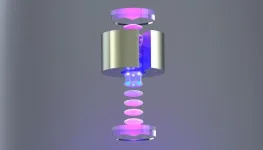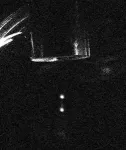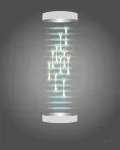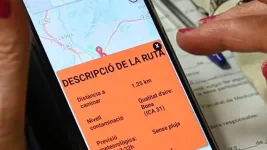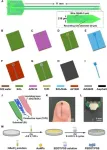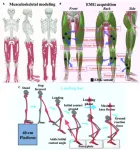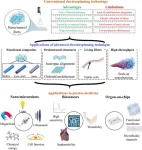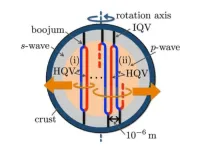(Press-News.org) Dark energy — a mysterious force pushing the universe apart at an ever-increasing rate — was discovered 26 years ago, and ever since, scientists have been searching for a new and exotic particle causing the expansion.
Pushing the boundaries of this search, University of California, Berkeley physicists have now built the most precise experiment yet to look for minor deviations from the accepted theory of gravity that could be evidence for such a particle, which theorists have dubbed a chameleon or symmetron.
The experiment, which combines an atom interferometer for precise gravity measurements with an optical lattice to hold the atoms in place, allowed the researchers to immobilize free-falling atoms for seconds instead of milliseconds to look for gravitational effects, besting the current most precise measurement by a factor of five.
Though the researchers found no deviation from what is predicted by the theory spelled out by Isaac Newton 400 years ago, expected improvements in the precision of the experiment could eventually turn up evidence that supports or disproves theories of a hypothetical fifth force mediated by chameleons or symmetrons.
The ability of the lattice atom interferometer to hold atoms for up to 70 seconds — and potentially 10 times longer — also opens up the possibility of probing gravity at the quantum level, said Holger Müller, UC Berkeley professor of physics. While physicists have well-tested theories describing the quantum nature of three of the four forces of nature — electromagnetism and the strong and weak forces — the quantum nature of gravity has never been demonstrated.
"Most theorists probably agree that gravity is quantum. But nobody has ever seen an experimental signature of that," Müller said. "It's very hard to even know whether gravity is quantum, but if we could hold our atoms 20 or 30 times longer than anyone else, because our sensitivity increases exponentially, we could have a 400 to 800,000 times better chance of finding experimental proof that gravity is indeed quantum mechanical."
Aside from precision measurements of gravity, other applications of the lattice atom interferometer include quantum sensing.
"Atom interferometry is particularly sensitive to gravity or inertial effects. You can build gyroscopes and accelerometers," said UC Berkeley postdoctoral fellow Cristian Panda, who is first author of a paper about the gravity measurements set to be published this week in the journal Nature and is co-authored by Müller. "But this gives a new direction in atom interferometry, where quantum sensing of gravity, acceleration and rotation could be done with atoms held in optical lattices in a compact package that is resilient to environmental imperfections or noise."
Because the optical lattice holds atoms rigidly in place, the lattice atom interferometer could even operate at sea, where sensitive gravity measurements are employed to map the geology of the ocean floor.
Screened forces can hide in plain sight
Dark energy was discovered in 1998 by two teams of scientists: a group of physicists based at Lawrence Berkeley National Laboratory, led by Saul Perlmutter, now a UC Berkeley professor of physics, and a group of astronomers that included UC Berkeley postdoctoral fellow Adam Riess. The two shared the 2011 Nobel Prize in Physics for the discovery.
The realization that the universe was expanding more rapidly than it should came from tracking distant supernovas and using them to measure cosmic distances. Despite much speculation by theorists about what's actually pushing space apart, dark energy remains an enigma — a large enigma, since about 70% of the entire matter and energy of the universe is in the form of dark energy.
One theory is that dark energy is merely the vacuum energy of space. Another is that it is an energy field called quintessence, which varies over time and space.
Another proposal is that dark energy is a fifth force much weaker than gravity and mediated by a particle that exerts a repulsive force that varies with the density of surrounding matter. In the emptiness of space, it would exert a repulsive force over long distances, able to push space apart. In a laboratory on Earth, with matter all around to shield it, the particle would have an extremely small reach.
This particle has been dubbed a chameleon, as if it's hiding in plain sight.
In 2015, Müller adapted an atom interferometer to search for evidence of chameleons using cesium atoms launched into a vacuum chamber, which mimics the emptiness of space. During the 10 to 20 milliseconds it took the atoms to rise and fall above a heavy aluminum sphere, he and his team detected no deviation from what would be expected from the normal gravitational attraction of the sphere and Earth.
The key to using free-falling atoms to test gravity is the ability to excite each atom into a quantum superposition of two states, each with a slightly different momentum that carries them different distances from a heavy tungsten weight hanging overhead. The higher momentum, higher elevation state experiences more gravitational attraction to the tungsten, changing its phase. When the atom's wave function collapses, the phase difference between the two parts of the matter wave reveals the difference in gravitational attraction between them.
"Atom interferometry is the art and science of using the quantum properties of a particle, that is, the fact that it's both a particle and a wave. We split the wave up so that the particle is taking two paths at the same time and then interfere them at the end," Müller said. "The waves can either be in phase and add up, or the waves can be out of phase and cancel each other out. The trick is that whether they are in phase or out of phase depends very sensitively on some quantities that you might want to measure, such as acceleration, gravity, rotation or fundamental constants."
In 2019, Müller and his colleagues added an optical lattice to keep the atoms close to the tungsten weight for a much longer time — an astounding 20 seconds — to increase the effect of gravity on the phase. The optical lattice employs two crossed laser beams that create a lattice-like array of stable places for atoms to congregate, levitating in the vacuum. But was 20 seconds the limit, he wondered?
During the height of the COVID-19 pandemic, Panda worked tirelessly to extend the hold time, systematically fixing a list of 40 possible roadblocks until establishing that the wiggling tilt of the laser beam, caused by vibrations, was a major limitation. By stabilizing the beam within a resonant chamber and tweaking the temperature to be a bit colder — in this case less than a millionth of a Kelvin above absolute zero, or a billion times colder than room temperature — he was able to extend the hold time to 70 seconds.
He and Müller published those results in the June 11, 2024, issue of Nature Physics.
Gravitational entanglement
In the newly reported gravity experiment, Panda and Müller traded a shorter time, 2 seconds, for a greater separation of the wave packets to several microns, or several thousandths of a millimeter. There are about 10,000 cesium atoms in the vacuum chamber for each experiment — too sparsely distributed to interact with one another — dispersed by the optical lattice into clouds of about 10 atoms each.
"Gravity is trying to push them down with a force a billion times stronger than their attraction to the tungsten mass, but you have the restoring force from the optical lattice that's holding them, kind of like a shelf," Panda said. "We then take each atom and split it into two wave packets, so now it's in a superposition of two heights. And then we take each one of those two wave packets and load them in a separate lattice site, a separate shelf, so it looks like a cupboard. When we turn off the lattice, the wave packets recombine, and all the quantum information that was acquired during the hold can be read out."
Panda plans to build his own lattice atom interferometer at the University of Arizona, where he was just appointed an assistant professor of physics. He hopes to use it to, among other things, more precisely measure the gravitational constant that links the force of gravity with mass.
Meanwhile, Müller and his team are building from scratch a new lattice atom interferometer with better vibration control and a lower temperature. The new device could produce results that are 100 times better than the current experiment, sensitive enough to detect the quantum properties of gravity. The planned experiment to detect gravitational entanglement, if successful, would be akin to the first demonstration of quantum entanglement of photons performed at UC Berkeley in 1972 by the late Stuart Freedman and former postdoctoral fellow John Clauser. Clauser shared the 2022 Nobel Prize in Physics for that work.
Other co-authors of the gravity paper are graduate student Matthew Tao and former undergraduate student Miguel Ceja of UC Berkeley, Justin Khoury of the University of Pennsylvania in Philadelphia and Guglielmo Tino of the University of Florence in Italy. The work is supported by the National Science Foundation (1708160, 2208029), Office of Naval Research (N00014-20-1-2656) and Jet Propulsion Laboratory (1659506, 1669913).
END
Precision instrument bolsters efforts to find elusive dark energy
Experiment captures atoms in free fall to look for gravitational anomalies caused by universe's missing energy
2024-06-26
ELSE PRESS RELEASES FROM THIS DATE:
Overcoming challenges encountered by Spanish-speaking trauma patients
2024-06-26
Key Takeaways
Spanish-speaking patients who suffer traumatic injuries face gaps in their care once they leave the hospital, many with a high need for mental health services.
More than half of the patients studied reported food insecurity, transportation challenges, and needing help with utilities.
A novel care pathway developed by researchers can help connect these patients with needed services.
CHICAGO – Many trauma patients face a myriad of challenges when recovering from a traumatic injury, ...
Every walk you take: Promoting active and healthy ageing of citizens
2024-06-26
Promoting active and healthy ageing of citizens through a new mobile application that shows walking routes through green areas in Barcelona with data on geolocation, obstacles, pollution and weather in real time: this is the aim of the citizen science project Every Walk You Take, promoted by a team from the University of Barcelona. This initiative aims to promote physical activity and health among the over-fifty-five population through a new mobile-assisted health intervention (mHealth).
This innovative app, presented in an article published in Sustainability ...
Innovative research unveils link between depression and amygdala activity in rats
2024-06-26
A significant new study published in the Cyborg Bionic Systems journal by Fanli Kong and colleagues sheds light on the intricate relationship between depression and brain activity, particularly focusing on the basolateral amygdala (BLA) in rats. This research offers compelling insights into how depression can alter neural circuits and could pave the way for new treatments.
Depression is a debilitating mental health issue affecting millions worldwide and is known for symptoms like persistent sadness, loss of interest in enjoyable activities, and fatigue. While traditional treatments have focused on neurotransmitters in the brain, this study dives deeper into the brain’s structural ...
Navigating the fine line between performance and safety in sports: Insights from landing mechanics research
2024-06-26
The recent study by Datao Xu and his team at Ningbo University has unveiled important strategies that can be applied in athletic training and rehabilitation to curb the high rates of lower limb injuries. Their research meticulously analyzes the mechanics of single-leg landings—a common move in various sports—to propose enhanced landing techniques that not only aim to protect athletes but also improve their performance by enabling quicker recovery and continuation in sports activities.
One of the study’s most significant contributions is its detailed exploration of the role of ankle dynamics in absorbing landing impacts. ...
Innovative electrospinning techniques revolutionize precise medicine through advanced medical devices
2024-06-26
In a groundbreaking advancement that could reshape the landscape of precise medicine, researchers from the Beijing Institute of Technology and Rutgers University have unveiled a series of innovative electrospinning techniques capable of significantly enhancing the functionality and effectiveness of medical devices. This pioneering study, recently published in the Cyborg Bionic Systems journal, promises to revolutionize the creation and implementation of nano/microrobots, wearable/implantable biosensors, and organ-on-chip systems.
Precise medicine, aimed at tailoring healthcare to individual patients ...
PLOS announces new publishing agreement with Colombian consortium
2024-06-26
SAN FRANCISCO —The Public Library of Science (PLOS) is pleased to announce a consortium agreement with Consorcio Colombia / Consortia facilitated by Accucoms, that allows joining member institutions to participate in PLOS’ three innovative publishing models across all 14 PLOS titles. The agreement provides researchers from affiliated institutions unlimited publishing privileges in PLOS journals without incurring fees. Eight Colombian institutions have joined the agreement in 2024 [1], and more institutions are expected to join in the following years.
“Consorcio ...
New survey from NCCN finds cancer drug shortage management remains a moving target, impacting clinical trials
2024-06-26
PLYMOUTH MEETING, PA [June 26, 2024] — The National Comprehensive Cancer Network® (NCCN®)—a nonprofit alliance of leading cancer centers—is publishing new results for its latest survey on cancer drug shortages in the United States. This follows data published one year ago, and six months ago, illustrating how up to 93% of centers surveyed were experiencing shortages of the crucial chemotherapy carboplatin at its peak. In June 2023, 70% of centers surveyed were also lacking adequate supply for cisplatin. In the latest survey, only 11% of surveyed centers reported a shortage of carboplatin and 7% for cisplatin; but new concerns have emerged.
“Critical ...
Biting flies on dairy farms can spread bovine mastitis
2024-06-26
Highlights:
Bovine mastitis is a potentially fatal condition with myriad known causes, including bacteria.
Biting flies may help cause mastitis, but the mechanisms are not well elucidated.
Researchers characterized microbial diversity in biting flies and manure to look for connections.
The flies carried relevant bacterial strains, also found in the manure, associated with mastitis.
The research may point to new strategies for protecting cows from disease-causing pathogens.
Washington, D.C.—Bovine mastitis, which affects cows, leads to reduced milk production and can be fatal if left untreated. The USDA National Animal Health Monitoring ...
Balancing act: Novel wearable sensors and AI transform balance assessment
2024-06-26
Balance can be impacted by various factors, including diseases such as Parkinson’s disease, acute and chronic injuries to the nervous system, and the natural aging process. Accurately assessing balance in patients is important to identify and manage conditions that affect coordination and stability. Balance assessments also play a key role in preventing falls, understanding movement disorders, and designing appropriate therapeutic interventions across age groups and medical conditions.
However, traditional methods used to assess balance often suffer from subjectivity, are not comprehensive enough and cannot be administered remotely. Moreover, these assessments rely on expensive, ...
Study reveals twisted origin of dead stars’ mysterious ‘heartbeats’
2024-06-26
Stars blinking code in Netflix’s “3 Body Problem” might be science fiction, but by deciphering neutron stars’ erratic flickers, a new study has revealed the twisted origin of these dead stars’ mysterious “heartbeats.”
When neutron stars—ultra-dense remnants of massive stars that exploded in supernovae—were first discovered in 1967, astronomers thought their strange periodic pulses could be signals from an alien civilization. Although we now know these “heartbeats” ...
LAST 30 PRESS RELEASES:
Post-stroke injection protects the brain in preclinical study
Cardiovascular risk score predicts multiple eye diseases
Health: estimated one in ten British adults used or interested in GLP-1 medications for weight loss
Exercise to treat depression yields similar results to therapy
Whooping cough vaccination for pregnant women strengthens babies’ immune system
Dramatic decline in new cases of orphanhood in Uganda driven by HIV treatment and prevention programs
Stopping weight loss drugs linked to weight regain and reversal of heart health markers
Higher intake of food preservatives linked to increased cancer risk
Mass General Brigham–developed cholera vaccine completes phase 1 trial
First experimental validation of a “150-year-old chemical common sense” direct visualization of the molecular structural changes in the ultrafast anthracene [4+4] photocycloaddition reaction
Lack of support for people on weight loss drugs leaves them vulnerable to nutritional deficiencies, say experts
Dogs’ dinners can have greater climate impact than owners’
Are you ready to swap salmon for sprats and sardines?
1.6 million UK adults used weight loss drugs in past year
American College of Cardiology comments on new dietary guidelines for Americans
American Society of Gene & Cell Therapy and Orphan Therapeutics Accelerator partner to advance and commercialize promising rare disease treatments
One in 14 patients having day case surgery have new or worse chronic pain 3 months after their operation
New study highlights link between eviction rates and gun violence
Heatwaves heat up soil but not toxin levels in rice, study finds
Digital modeling reveals where construction carbon emissions really come from
Turning farm waste into water filters
New study shows how the spleen helps the immune system accept a transplant
New Mayo Clinic study advances personalized prostate cancer education with an EHR-integrated AI agent
Researchers identify novel therapeutic target to improve recovery after nerve injury
Microbes in breast milk help populate infant gut microbiomes
Reprogramming immunity to rewrite the story of Type 1 diabetes
New tool narrows the search for ideal material structures
Artificial saliva containing sugarcane protein helps protect the teeth of patients with head and neck cancer
Understanding the role of linear ubiquitination in T-tubule biogenesis
Researchers identify urban atmosphere as primary reservoir of microplastics
[Press-News.org] Precision instrument bolsters efforts to find elusive dark energyExperiment captures atoms in free fall to look for gravitational anomalies caused by universe's missing energy
